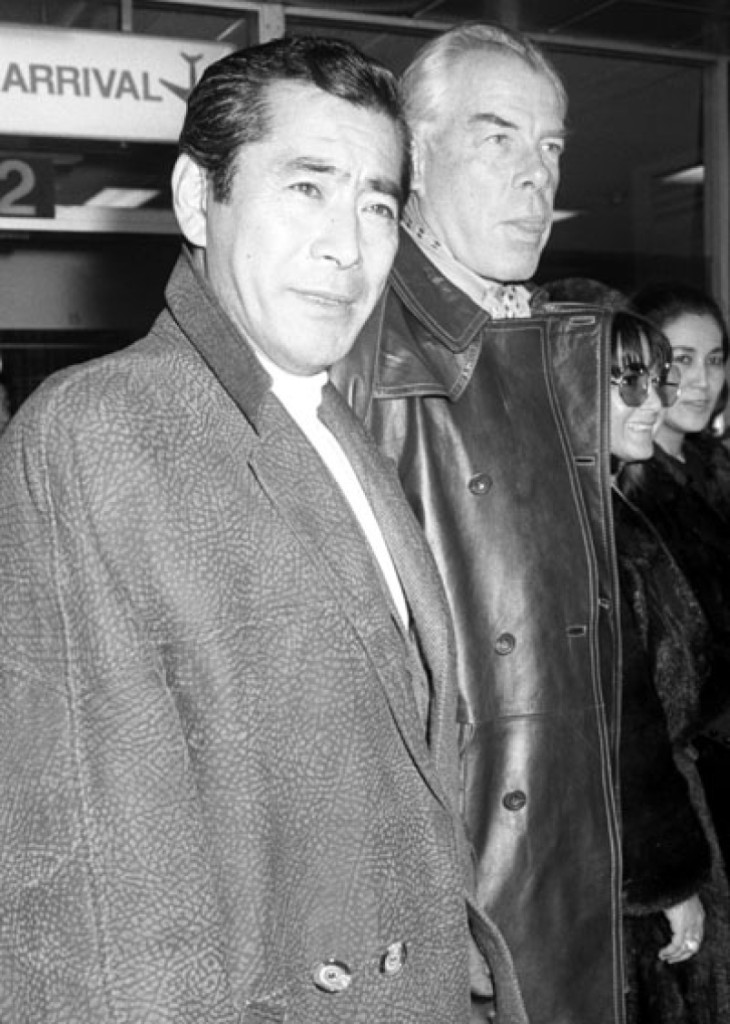 If he was still alive, Legendary Japanese actor Toshiro Mifune would have been 95 years old this week. He was born on April 1, 1920. I was idly looking on the Internet for images of the imposing Mifune, when I found the fantastic picture above. I don’t know exactly when and where it was taken, but in all likelihood, it was London, sometime in 1967.
If he was still alive, Legendary Japanese actor Toshiro Mifune would have been 95 years old this week. He was born on April 1, 1920. I was idly looking on the Internet for images of the imposing Mifune, when I found the fantastic picture above. I don’t know exactly when and where it was taken, but in all likelihood, it was London, sometime in 1967.
Mifune and Lee Marvin worked once together, on John Boorman’s 1968 strange, hallucinogenic war film, Hell In the Pacific. The film was a pet project of Marvin’s and he was reportedly devastated by the fact it did not do well critically or at the box office.
For those of you who are not familiar with the film, Mifune and Marvin played a Japanese navy captain and a US air force pilot, respectively, who are marooned on a remote island in the Pacific and continue to engage in version of the larger war raging around them. In some respects, the film mirrored the real lives of both men. Marvin had served in the war and been wounded in action during the battle for Saipan, while Mifune had served in the Japanese imperial army.
Mifune had approached Marvin with an eye to working with US actor. Despite being somewhat hostile towards Mifune, Marvin agreed to meet. They got together in London and, despite their history on different sides of the war and the fact Marvin could not speak Japanese and Mifune very little English, they hit it off very well. They spent a night on the town in London and later on, in the process of developing Hell In the Pacific, Marvin travelled to Japan where the two had another lengthy drinking session.
In all likelihood, the image above may have been taken during their time in London. It reminded me of the story behind the making of Hell In the Pacific and how Mifune and Marvin became friends. This tale was basis for my short story ‘Gone Fishing’, which appeared in an anthology I helped edit called LEE, published by Crime Factory Publications in 2013. ‘Gone Fishing’ is set on a marlin fishing boat off the coast of the Cairns after the release of Hell In the Pacific, and features a despondent Marvin recalling the making of the film, his friendship with Mifune and his time in the war.
LEE contains 17 stories from crime writers around the world, including Adrian McKinty, Jake Hinkson, Scott Phillips, Heath Lowrance, Jenna Bass, Eric Beetner, Johnny Shaw, Roger Smith and a host of others. They are all based on the life of the iconic US actor. The stories veer in tone and style from literary noir to the wickedly gonzo. The one thing they all have in common is a respect for Marvin, his life and his work.
I have a real soft spot for LEE. Unfortunately, it didn’t sell very well, but of all the books Crime Factory Publications has released, it is my favourite. If you are a fan of Marvin’s work and looking for something to read over the Easter break, I’d encourage you to purchase the Kindle version or, for a little more, you can get the paperback version from Crime Factory Publications website here.
In the meantime, happy birthday Toshiro Mifune.




















One of the true greats – his charisma just leaps out at you – on-screen and off!
I agree. He was a giant in so many films.
HELL IN THE PACIFIC was later adapted by Barry Longyear for the Short story “Enemy Mine” which became a lamentable film of the same name in 1985 featuring Dennis Quaid.
Marvin and Mifune are a great combination.
Where can I find your story “Gone Fishing”, the Crime Factory link seems kaput and I can’t find “LEE” on Amazon.
Trying to find some interesting Hollywood and non-Hollywood celebrity quotes regarding Toshiro Mifune.
Mattel,
Crime Factory Publications is no more, I am afraid.
I still have copies of the LEE paperback…. A lot of copies. Let me know where you are and I’ll post you a copy for $15 plus postage.
Cheers,
Andrew
Thank you for creating LEE
Jason,
Thank you for reading. Of the 8 or 9 books Crime Factory published, this was, hands down, my favourite. I wish it had been more successful.
Cheers,
Andrew
In association with Mifune’s 100th I read Dwayne Epstein’s bio of Lee Marvin. According to him (quoting Marvin’s first wife Betty), Marvin was such a fanboy when it came to Mifune that from the early 1950s they would go to every new Mifune film as it was released. He would do drunken samurai routines at parties and call Mifune up to have long conversations even though Mifune didn’t speak English. According to Epstein, it was a dream project for Marvin to be able to work with Mifune and when he and Boorman came up with the HITP project after Point Blank, it was they who did the approaching.
Although Mifune and Boorman didn’t get along, he and Marvin hit it off. Mifune still didn’t speak English, but he and Marvin would drink together every night and then be on time to the set every day. Marvin still spoke glowingly of Mifune–his talent and his professionalism–after the movie was made.
It’s a pity the movie has certain basic flaws, such as neither making the slightest effort to teach the other even one word of his own language–but I still find it very watchable for the beautiful cinematography and for its two stars, who both do a great job.